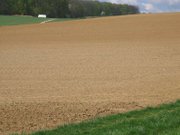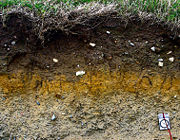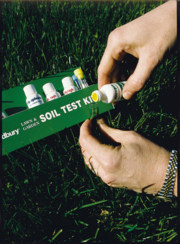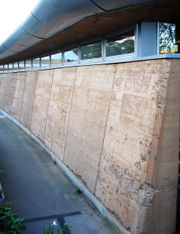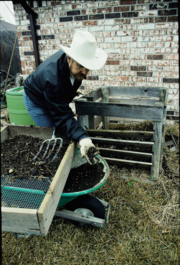Soil
2008/9 Schools Wikipedia Selection. Related subjects: Geology and geophysics
Soil is the naturally occurring, unconsolidated or loose covering of broken rock particles and decaying organic matter on the surface of the Earth, capable of supporting life. Soil particles pack loosely, forming a soil structure filled with pore spaces. These pores contain soil solution (liquid) and air (gas) Accordingly, soils are often treated as a three state system. Soil is also known as earth: it is the substance from which our planet takes its name.
Characteristics
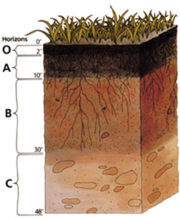
Soil colour is the first impression one has when viewing soil. Striking colors and contrasting patterns are especially memorable. The Red River in Louisiana carries sediment eroded from extensive reddish soils like Port Silt Loam in Oklahoma.
Soil colour results in from chemical and biological weathering. As the primary minerals in parent material weather, the elements combine into new and colorful compounds. Iron forms secondary minerals with a yellow or red colour; organic matter decomposes into brown compounds; and manganese, sulfur and nitrogen can form black mineral deposits.
Soil structure is the arrangement of soil particles into aggregates. These may have various shapes, sizes and degrees of development or expression.
Soil texture refers to sand, silt and clay composition. Sand and silt are the product of physical weathering while clay is the product of chemical weathering. Clay content is particularly influential on soil behaviour due to a high retention capacity for nutrients and water.
The electrical resistivity of soil can affect the rate of galvanic corrosion of metallic structures in contact with it. Higher moister content or increased electrolyte concentration can lower the resistivity and thereby increase the rate of corrosion. Soil resistivity values typically range from about 100 to 1000 Ω· m, but more extreme values are not unusual.
Formation
Soil formation, or pedogenesis, is the combined effect of physical, chemical, biological, and anthropogenic processes on soil parent material resulting in the formation of soil horizons. Soil is always changing. The long periods over which change occurs and the multiple influences of change mean that simple soils are rare. While soil can achieve relative stability in properties for extended periods of time, the soil life cycle ultimately ends in soil conditions that leave it vulnerable to erosion. Little of the soil continuum of the earth is older than Tertiary and most no older than Pleistocene. Despite the inevitability of soils retrogression and degradation, most soil cycles are long and productive. How the soil "life" cycle proceeds is influenced by at least five classic soil forming factors: regional climate, biotic potential, topography, parent material, and the passage of time.
An example of soil development from bare rock occurs on recent lava flows in warm regions under heavy and very frequent rainfall. In such climates plants become established very quickly on basaltic lava, even though there is very little organic material. The plants are supported by the porous rock becoming filled with nutrient bearing water, for example carrying dissolved bird droppings or guano. The developing plant roots themselves gradually breaks up the porous lava and organic matter soon accumulates but, even before it does, the predominantly porous broken lava in which the plant roots grow can be considered a soil.
In nature
Biogeography is the study of spatial variations in biological communities. Soils are a restricting factor as to what plants can grow in which environments. Soil scientists survey soils in the hope of understanding controls as to what vegetation can and will grow in a particular location
Geologists also have a particular interest in the patterns of soil on the surface of the earth. Soil texture, colour and chemistry often reflect the underlying geologic parent material and soil types often change at geologic unit boundaries. Buried paleosols mark previous land surfaces and record climatic conditions from previous eras. Geologists use this paleopedological record to understand the ecological relationships in past ecosystems. According to the theory of biorhexistasy, prolonged conditions conducive to forming deep, weathered soils result in increasing ocean salinity and the formation of limestone.
Geologists use soil profile features to establish the duration of surface stability in the context of geologic faults or slope stability. An offset subsoil horizon indicates rupture during soil formation and the degree of subsequent subsoil formation is relied upon to establish time since rupture.
Soil examined in shovel test pits is used by archaeologists for relative dating based on stratigraphy (as opposed to absolute dating). What is considered most typical is to use soil profile features to determine the maximum reasonable pit depth than needs to be examined for archaeological evidence in the interest of cultural resources management.
Soils altered or formed by man (anthropic and anthropogenic soils) are also of interest to archaeologists. An example is Terra preta do Indio.
Uses
Soil material is a critical component in the mining and construction industries. Soil serves as a foundation for most construction projects. Massive volumes of soil can be involved in surface mining, road building, and dam construction. Earth sheltering is the architectural practice of using soil for external thermal mass against building walls.
Soil resources are critical to the environment, as well as to food and fibre production. Soil provides minerals and water to plants. Soil absorbs rainwater and releases it later thus preventing floods and drought. Soil cleans the water as it percolates. Soil is the habitat for many organisms.
Waste management often has a soil component. Septic drain fields treat septic tank effluent uses aerobic soil processes. Landfills use soil for daily cover.
Organic soils, especially peat, serve as a significant fuel resource.
Both humans in many cultures and animals occasionally eat soil.
Degradation
Land degradation is a human induced or natural process which impairs the capacity of land to function. Soils are the critical component in land degradation when it involves acidification, contamination, desertification, erosion, or salination.
While soil acidification of alkaline soils is beneficial, it degrades land when soil acidity lowers crop productivity and increases soil vulnerability to contamination and erosion. Soils are often initially acid because their parent materials were acid and initially low in the basic cations (calcium, magnesium, potassium, and sodium). Acidification occurs when these elements are removed from the soil profile by normal rainfall or the harvesting of crops. Soil acidification is accelerated by the use of acid-forming nitrogenous fertilizers and by the effects of acid precipitation.
Soil contamination at low levels are often within soil capacity to treat and assimilate. Many waste treatment processes rely on this treatment capacity. Exceeding treatment capacity can damage soil biota and limit soil function. Derelict soils occur where industrial contamination or other development activity damages the soil to such a degree that the land cannot be used safely or productively. Remediation of derelict soil uses principles of geology, physics, chemistry, and biology to degrade, attenuate, isolate, or remove soil contaminants and to restore soil functions and values. Techniques include leaching, air sparging, chemical amendments, phytoremediation, bioremediation, and natural attenuation.
Desertification is an environmental process of ecosystem degradation in arid and semi-arid regions, or as a result of human activity. It is a common misconception that droughts cause desertification. Droughts are common in arid and semiarid lands. Well-managed lands can recover from drought when the rains return. Soil management tools include maintaining soil nutrient and organic matter levels, reduced tillage and increased cover. These help to control erosion and maintain productivity during periods when moisture is available. Continued land abuse during droughts, however, increases land degradation. Increased population and livestock pressure on marginal lands accelerates desertification.
Soil erosional loss is caused by wind, water, ice, movement in response to gravity. Although the processes may be simultaneous, erosion is distinguished from weathering. Erosion is an intrinsic natural process, but in many places it is increased by human land use. Poor land use practices include deforestation, overgrazing, and improper construction activity. Improved management can limit erosion using techniques like limiting disturbance during construction, avoiding construction during erosion prone periods, intercepting runoff, terrace-building, use of erosion suppressing cover materials and planting trees or other soil binding plants.
A serious and long-running water erosion problem is in China, on the middle reaches of the Yellow River and the upper reaches of the Yangtze River. From the Yellow River, over 1.6 billion tons of sediment flow each year into the ocean. The sediment originates primarily from water erosion in the Loess Plateau region of northwest China.
Soil piping is a particular form of soil erosion that occurs below the soil surface. It is associated with levee and dam failure as well as sink hole formation. Turbulent flow removes soil starting from the mouth of the seep flow and subsoil erosion advances upgradient. The term sand boil is used to describe the appearance of the discharging end of an active soil pipe.
Soil salination is the accumulation of free salts to such an extent that it leads to degradation of soils and vegetation. Consequences include corrosion damage, reduced plant growth, erosion due to loss of plant cover and soil structure, and water quality problems due to sedimentation. Salination occurs due to a combination of natural and human caused processes. Aridic conditions favour salt accumulation. This is especially apparent when soil parent material is saline. Irrigation of arid lands is especially problematic. All irrigation water has some level of salinity. Irrigation, especially when it involves leakage from canals, often raise the underlying water table. Rapid salination occurs when the land surface is within the capillary fringe of saline groundwater. Salinity control involves flushing with higher levels of applied water in combination with tile drainage..
